|
Amblyospiza albifrons
(Thick-billed weaver)
Dikbekwewer [Afrikaans]; Dikbekwever [Dutch];
Amblyospize à front blanc [French]; Weißstirnweber [German];
Tecelão-de-bico-grosso [Portuguese]
Life
> Eukaryotes >
Opisthokonta
> Metazoa (animals) >
Bilateria >
Deuterostomia > Chordata >
Craniata > Vertebrata (vertebrates) > Gnathostomata (jawed
vertebrates) > Teleostomi (teleost fish) > Osteichthyes (bony fish) > Class:
Sarcopterygii (lobe-finned
fish) > Stegocephalia (terrestrial
vertebrates) > Tetrapoda
(four-legged vertebrates) > Reptiliomorpha > Amniota >
Reptilia (reptiles) >
Romeriida > Diapsida > Archosauromorpha > Archosauria >
Dinosauria
(dinosaurs) > Saurischia > Theropoda (bipedal predatory dinosaurs) >
Coelurosauria > Maniraptora > Aves
(birds) > Order: Passeriformes
> Family: Ploceidae
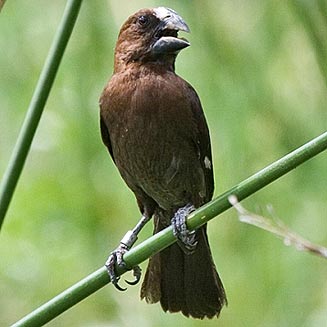 |
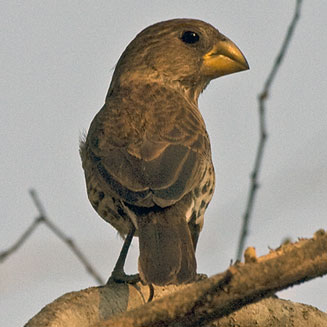 |
|
Thick-billed weaver male. [photo
Neil Gray
©] |
Thick-billed weaver female, Mpumalanga, South
Africa. [photo
Neil Gray
©] |
Distribution and habitat
Occurs in patches of West and East Africa, extending south
through Tanzania and northern DRC to Zambia, Angola and southern Africa. Here it
is locally common in northern Botswana, Caprivi Strip (Namibia), Zimbabwe's
eastern highlands, central and southern Mozambique and north-eastern and
south-eastern South Africa. In the breeding season it generally favours marshes,
rivers, dams with rank grass, reedbeds and Papyrus (Cyperus papyrus)
beds, but in the non-breeding season it prefers edges and clearings in evergreen
forest, also occupying reed-beds adjacent to ponds in suburban parks, alien
plantations and cultivated areas.
|
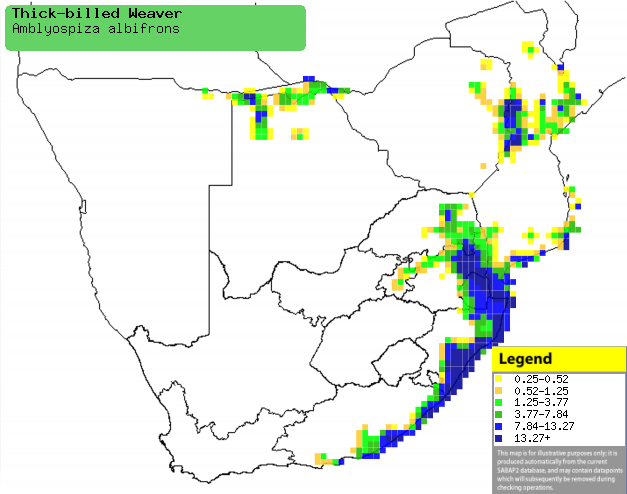 |
|
Distribution of Thick-billed weaver in southern Africa,
based on statistical smoothing of the records from first SA Bird Atlas
Project (©
Animal Demography unit, University of
Cape Town; smoothing by Birgit Erni and Francesca Little). Colours range
from dark blue (most common) through to yellow (least common).
See here for the latest distribution
from the SABAP2. |
Predators and parasites
It has been recorded as prey of African goshawk
(Accipiter tachiro).
Food
It mainly eats fruit and seeds, doing most of its foraging
in the forest canopy and on the ground, occasionally hawking termites aerially. The following food items have been recorded
in its diet:
- Plants
- fruit
- Celtis africana (White-stinkwood)
- Celtis mildbraedii (Red-fruit white-stinkwood)
- Chaetachme aristata (Thorny-elm)
- seeds
- Helianthus annuus (Sunflower)
- Coix lachryma-jobi (Job's tears)
- fruit and seeds
- Acacia robusta (River thorn)
- Albizia adianthifolia (Flat-crown albizia)
- Zanthoxylum davyi (Forest knobwood)
- Grewia (raisins)
- Kiggelaria africana (Wild peach)
- Syzygium cordatum (Waterberry)
- Ziziphus mucronata (Buffalo-thorn)
- alien plants
- Lantana camara (Cherry pie)
- Manihot palmate (Umbrella tree)
- Melia azedarach (Persian lilac)
- Morus (mulberries)
- Rhus succedanea (Wax-tree)
- Arthropods
- insects
- Lymnaea natalensis (water snail)
Breeding
- The nest (see images below) is built solely by the male in about 2-12
days, first constructing a cup (unlike other weavers such as
Ploceus) over which a dome is woven, forming
an oval-shaped structure with a side entrance. It is usually made of woven
material, usually Bulrush (Typha capensis) leaves, and once completed
and approved by the female she lines the interior with finer material. It is
typically suspended between at least two upright stems of Bulrush, reeds (Phragmites)
or Papyrus (Cyperus papyrus), more rarely in Garden canna (Canna
indica). Sometimes the male builds it in a tree adjacent to marshes, but
it is always rejected by the female.
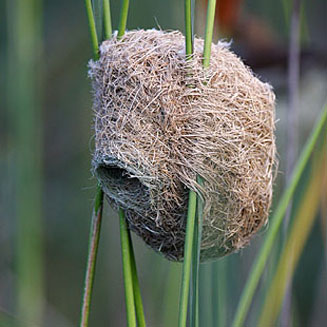 |
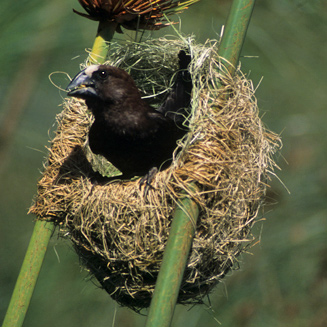 |
|
Thick-billed weaver nest, Hazyview, South Africa. [photo Warwick Tarboton ©] |
Thick-billed weaver male constructing the nest. [photo Peter Steyn
©] |
- Egg-laying season is from November-April.
- It lays 2-4 eggs, which are incubated solely by the female for about
14-16 days.
- The chicks are fed solely by the female on a diet of soft larvae,
insects and fruit pulp, leaving the nest after about 19-22 days.
Threats
Not threatened., in fact it has benefited from the
introduction of artificial wetlands.
References
-
Hockey PAR, Dean WRJ and Ryan PG 2005. Roberts
- Birds of southern Africa, VIIth ed. The Trustees of the John Voelcker
Bird Book Fund, Cape Town.
|
